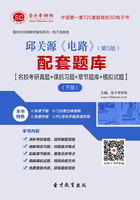
第10章 含有耦合电感的电路
一、选择题
1.电路如图10-1所示, 负载上获得的最大功率为( )。[电子科技大学2012研]
负载上获得的最大功率为( )。[电子科技大学2012研]

图10-1
A.
B.
C.
D.
【答案】B
【解析】将二次端口 电阻反映至一次端口的电阻为:
电阻反映至一次端口的电阻为: 。则由获得最大功率的条件有,当
。则由获得最大功率的条件有,当 时,
时, 电阻获得最大功率,为
电阻获得最大功率,为 。
。
2.如图10-2所示含正感正弦稳态电路,开路电压 等于( )。[西安电子科技大学2010研]
等于( )。[西安电子科技大学2010研]

图10-2
A.
B.
C.
D.
【答案】A
【解析】T形去耦,如图10-3所示。

图10-3
可得: 。
。
3.如图10-4所示含理想变压器电路,ab端的等效电阻为( )。[西安电子科技大学2009研]

图10-4
(上图中的S是电导的单位,西门子。)
A.1/2
B.2/3
C.1/8
D.1
【答案】A
【解析】等效电路图如图10-5所示。

图10-5
根据耦合电感的计算方法, ,所以
,所以 。
。
二、填空题
1.图10-6所示电路中的开头S在t=0时断开,则电压 =______。[华南理工大学 2012研]
=______。[华南理工大学 2012研]

图10-6
【答案】
【解析】用三要素法求解。
开关S打开前电路达到稳态,
开关S闭合后电路达到稳态时,
电路时间常数:
全电流:
由电感电压与电流关系得:
2.图10-7所示正弦稳态电路中,已知电流源iS=![]()
图10-7
【答案】
【解析】去耦之后,uab是(L1-M)=0.4H电感两端的电压,
所以

所以

3.图10-8所示电路中,有两个互感线圈1(电阻为R1、自感为L1)和2(电阻为R2、自感为L2),其中R1=20Ω,ωL1=80Ω,R2=30Ω,ωL2=50Ω,ωM=40Ω,电源电压
图10-8
【答案】 ;
; ;
; ;
; ;
; ;
;
【解析】对电路解耦,同名端相连,电感各减去互感,第三条支路增加为正的互感。
所以

 A
A

 A
A

 A
A
 VA
VA
 VA
VA

 VA
VA
三、计算题
1.如图10-9所示电路,已知![]()
 求:RL为何值时,其上可获得最大功率?最大功率是多少?[同济大学2007研]
求:RL为何值时,其上可获得最大功率?最大功率是多少?[同济大学2007研]

图10-9
解:将原边电路等效至副边,如图10-10所示。

图10-10
其中

所以戴维南等效电路中的等效阻抗为:

等效电压源为:
 V
V
则RL吸收的功率为:

令
图10-11
解:由图可得两组耦合电感的互感为:

结合题意并根据节点KVL方程得:

由于中间回路为无源回路,所以电流i初值为0,即 ,
,
联立以上各式解得:

3.图10-12(a)所示的电路中,已知U=200V,ω=104rad/s,R=100Ω,L1=30mH,L2=1OmH,M=10mH,求使电路发生并联谐振的电容值C及各电流表的读数。[华南理工大学2004研]

图10-12
解:去耦合后的等效电路如图(b)所示,当右边两并联支路发生并联谐振时,有

发生并联谐振时,谐振的部分无电阻,相当于开路,所以电流表A和A1的读数相同,其值为:

此时并联支路电压等于电源的电压,所以A2和A3的读数也相同,其值为:

4.如图10-13所示电路中,左侧线圈自感 ,右侧线圈自感
,右侧线圈自感 。两个线圈之间的互感
。两个线圈之间的互感 为
为 。电路原已达稳态,
。电路原已达稳态, 时开关
时开关 闭合,求开关
闭合,求开关 闭合后的电流
闭合后的电流 。[西安交通大学2008研]
。[西安交通大学2008研]

图10-13
解:根据绕组的绕向判断同名端如图中所示,列写KVL方程:


代入数值并整理得: 。
。
求解微分方程得:

因此,开关闭合后电流
5.求图10-14中ab输入端口的谐振角频率ω0。[同济大学2007研]

图10-14
解:将互感电路解耦

等效电路如图10-15所示。

图10-15
所以谐振角频率为:![]() 。
。
6.如图10-16所示正弦稳态电路,已知![]() 欲使us和i同相位,求参数C。[华中科技大学2007研]
欲使us和i同相位,求参数C。[华中科技大学2007研]

图10-16
解:将互感电路解耦后的电路如图10-17所示。

图10-17
由于ω=4rad/s,所以

可进一步简化为如图10-18所示的电路。

图10-18
若us和i同相位,则电路中除1Ω电阻以外的电路等效电感的虚部为零,即

解得

7.如图10-19所示稳态电路中,us(t)为正弦电压源(ω=10rad/s),E0为直流电压源,电压表的读数为12V,电流表的读数为2.5A(均为有效值)。求各电源提供的功率。[华中科技大学2006研]

图10-19
解:互感解耦后的电路如图10-20所示。

图10-20
当直流电源E0单独作用时,us(t)短路,电感短路,电容开路,电压表和电流表读数分别为

当us(t)单独作用时,E0短路,假设电容支路的电流为i1=2.5∠0°A,则电压表读数为

又因为 所以直流电源发出的功率为
所以直流电源发出的功率为

所以us(t)发出的功率为

8.如图10-21所示电路,已知

 求:RL为何值时,其上可获得最大功率?最大功率是多少?[同济大学2007研]
求:RL为何值时,其上可获得最大功率?最大功率是多少?[同济大学2007研]

图10-21
解:将原边电路等效至副边,如图10-22所示。

图10-22
其中

所以戴维南等效电路中的等效阻抗为

等效电压源为

则RL吸收的功率为

 可得RL=202.7Ω,
可得RL=202.7Ω,
此时最大功率为